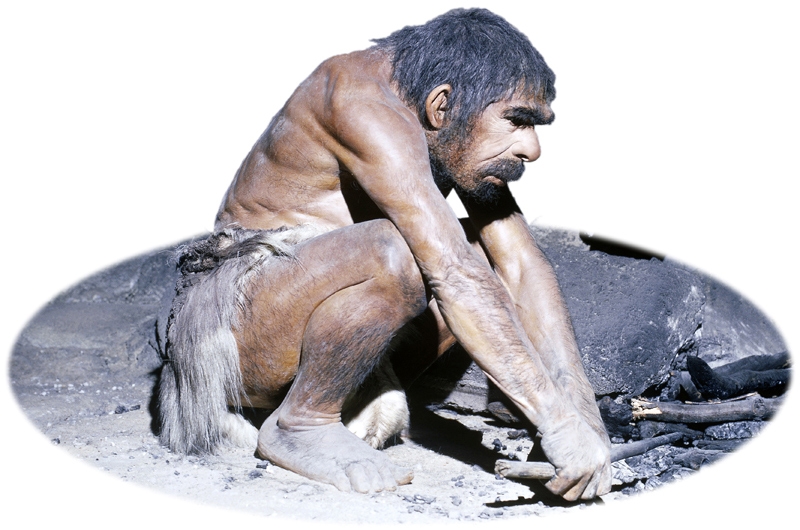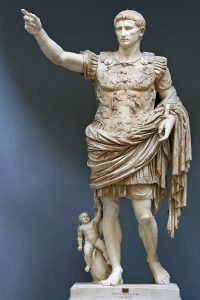The human species that today makes astounding advances in technology, and particularly in the medical field, did not exist four million years ago. In fact, hominids of that period were very different from the modern species in many ways. How did humans evolve to become today’s humans? How did Homo sapiens become so innovative? For one, they developed favorable qualities that were essential for adaptation and a thriving existence.

Homo sapiens derived from a form of early humans called Neanderthal. Unlike modern humans, characteristics of the Neanderthal included occipital buns and protruded brow ridges.1 One important facial feature of the Neanderthal was their large nose for “humidifying and warming cold, dry air” before it reached the lungs.2 Modern humans do not have this characteristic due to the fact that the Neanderthals lived in much harsher conditions. Thanks to the work of archaeologists and anthropologists, we know a great deal about the life and world of Neanderthals. The first fossils of these humans were found in France, and scholars have since called these humans Cro-Magnon. They created innovative tools from bones and antlers for hunting. This enabled them to survive and thrive in their environment. They even created artwork “in the form of decorated tools, beads, ivory carvings of humans and animals, clay figurines, musical instruments, and cave paintings.”3

Homo sapiens originated from East Africa. From there homo sapiens have migrated to all of earth’s main land masses. By taking advantage of land bridges, they have spread to Indonesia, New Guinea, Australia, and the Americas. Another contributing factor to the spreading of humans was the recent major Ice Age. The freezing of the oceans’ waters around the polar caps lowered the sea level, which exposed land bridges between land masses that were otherwise under water. For example, the connection between Calabria and Sicily had a sea level around -126 meters.4 They were able to adapt to the different environments due to their larger brain capacities, hence more intelligence. Having the knowledge that they had, they were able to create warm clothes and shelters to survive under various harsh conditions in the regions they occupied. Since they were nomadic people, there was no economic prosperity during the Paleolithic era. This was due to the fact that they never inhabited an area for a long duration of time. They were foragers; they scrapped up whatever they could find for survival, so there was no time period in which they could accumulate wealth. With that being said, that meant that there were no social classes. Instead, they lived an egalitarian lifestyle. While the men hunted, the women gathered. This method sustained their existence until the Neolithic Revolution, which domesticated both plants and animals.
The evolution of earlier hominids to Homo sapiens opened the door to a species capable of more advanced thinking about their surroundings and survival. The human race has since continued to thrive to the present. Without their innovative tools, body structures, and eventually domestication of plants and animals, Homo sapiens would not have been able to produce the advancements in technology and sciences that we have available today.
- Markus Bastir, Paul O’Higgins, and Antonio Rosas, “Facial Ontogeny in Neanderthals and Modern Humans,” Proceedings of the Royal Society B: Biological Sciences 274, no. 1614 (May 7, 2007): 1125–32. ↵
- Todd C. Rae, Thomas Koppe, and Chris B. Stringer, “The Neanderthal Face Is Not Cold Adapted,” Journal of Human Evolution 60, no. 2 (February 2011): 234–239. ↵
- “Evolution: Humans: Origins of Humankind.” Accessed September 10, 2016. http://www.pbs.org/wgbh/evolution/humans/humankind/o.html. ↵
- Fabrizio Antonioli, V. Lo Presti, M. G. Morticelli, M. A. Mannino, Kurt Lambeck, Luigi Ferranti, Catriona Bonfiglioli, et al., “The Land Bridge between Europe and Sicily over the Past 40 Kyrs: Timing of Emersion and Implications for the Migration of Homo Sapiens,” Rendiconti Online Societa Geologica Italiana, 2012. https://openresearch-repository.anu.edu.au/handle/1885/71477. ↵



99 comments
Zaraly Frasquillo
I was drawn to this article because I love learning different ideas or perspectives on how we, as a human race, began to be. I am a firm believer that God was the one who created the human race, but this was very interesting. I really liked your article Soki, it had me wanting to know more about the Neanderthal, so I googled pictures (looks a little like my brother).
Cameron Mays
This is one of the most interesting topics of history because it ties together history and sciences, by talking about evolution, so I was immediately drawn to your article because you made a superb topic choice. I feel as if you didn’t delve deep enough into the various stages of human evolution and if you did this article would have been even better. Otherwise, I liked it.
Mariana Govea
I really enjoyed reading this article, and the way it was organized it helped the reader follow the main idea very thoroughly and very well explained. I found this article very interesting because even though we have all heard a lot about the Neanderthals i really did not know much about how their physical appearance was and why it was the way it was. When one as human being is compared to the neanderthal you think that they were very much like you, but after reading this article the writer made the similarities and differences between us very visible.As well as it is just very interesting to know about humans and how we all started, as well as I read in the article I find it so crazy how all life lived under one continent and as time evolved and the neanderthals started to migrate to different conditions and places, the neanderthal started to evolve into the human we are today to adapt to its environment. Great job!:)
Esperanza Mauricio
I like to read about older species of human and their differences to the modern image. The nose difference is quite interesting and very fun to imagine. This was very fun to read.
Mehmet Samuk
I found the information in the article very interesting. I never knew why their noses were so big for instance. My roommates and I had a road trip to Colorado and on the way, we visited an old tribe aneshazis, they were also living like these early human forms, ever since then I have been interested in the beginnings of civilization.
Valerie Bernardin
Excellent article. It is fascinating to learn how the faces our distant ancestors changed.
Jezel Luna
The sequential of events you took the reader through were impeccable and assisted the reader to follow along smoothly. It amazes me to hear how earlier humans had to adapt to their harsh environments. I don’t think many people would be able to live in the different types of environment, mostly because so many of us are so pampered and taken care of. If we think our society is so advanced as of right now, I wonder what we’ll think when we are in our fifties. Great descriptive article!
Yesenia Cardenas
I find it so interesting for far the human species has come over the thousands of years. You did a great job explaining the evolution of homo sapiens. It makes me wonder how else the homo sapiens will evolve through time. This was a very informative and fun read, Great job!
Celina Resendez
I really enjoyed how you took the reader through the evolution of homo sapiens. The Ice Age played a major role in the spreading of peoples throughout the world and one day, in the very, very, VERY far future, the continents will come together once again. If only we were going to be around to see what a world that would be!
Aylin Salinas
It was very interesting reading about how we evolved into the beings that we are today. Many changes throughout history have caused us to evolve as a species. One day this will once again occur to us and we will become even more knowledgeable and adapt once more to our surroundings. Charles Darwin’s The Origin of Species by Means of Natural Selection mentions how species adapt to fit their environment just as how we have over the years. Very well-articulated article!